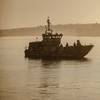What happens to shipwrecks in the deep waters of the Gulf of Mexico, and why is the answer so important to the oil and gas industry? A team of world-renowned, multidisciplinary scientists representing the federal government, academia, and industry will begin a biological and archaeological investigation of World War II shipwrecks in the deep waters of the Gulf that will address those questions and many more.
Just as the importance of our oceans is being recognized and studied by several independent commissions, this research mission will provide new information to answer questions about some of the least studied areas of the Gulf. The $1.2 million study will take 18 days and employ the use of a Remotely Operated Vehicle (ROV) to explore selected deepwater shipwrecks.
In addition to the archaeological and historical aspects of the study, the biological questions -- Do manmade structures function as artificial reefs in deepwater? What is the effect of the structure on the environment? What effect does the environment have on the structure? -- have serious implications for the thousands of oil and gas platforms used in the Gulf.
Scientists from the team will be on hand at the media availability in Houston this Thursday to discuss plans for the research cruise, use of the ROV, explain the public educational outreach component of the study, and answer questions.
The announcement is being held at the Sonsub Facility to allow for filming and photo opportunity with an ROV and with a model of the sunken German U-boat that is part of the study along with video footage.
Featured videos

Inmarsat Enhances Service to Drive Digitalization

Inside the Electrified Truckable Tug

Tracking Foreign Vessels Working in the U.S. Jones Act Market
Subscribe for
Maritime Reporter E-News
Maritime Reporter E-News is the maritime industry's largest circulation and most authoritative ENews Service, delivered to your Email five times per week









